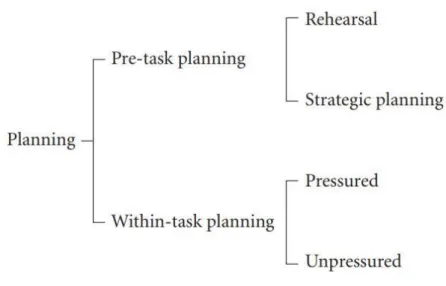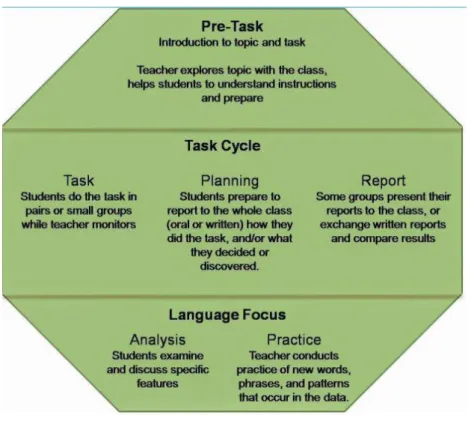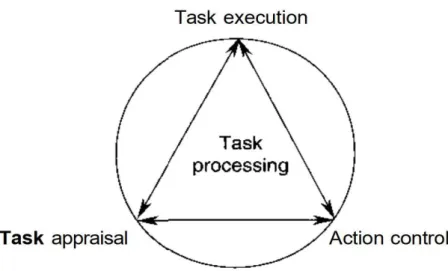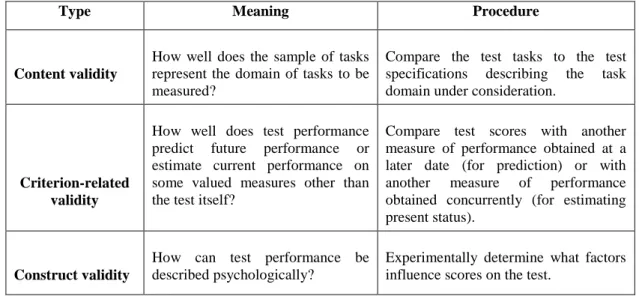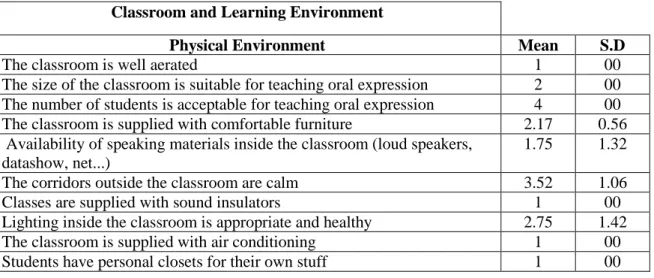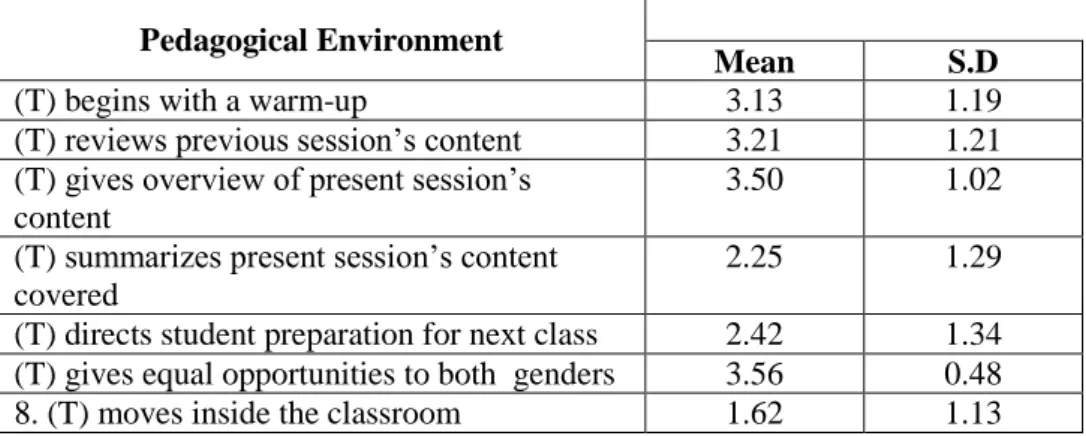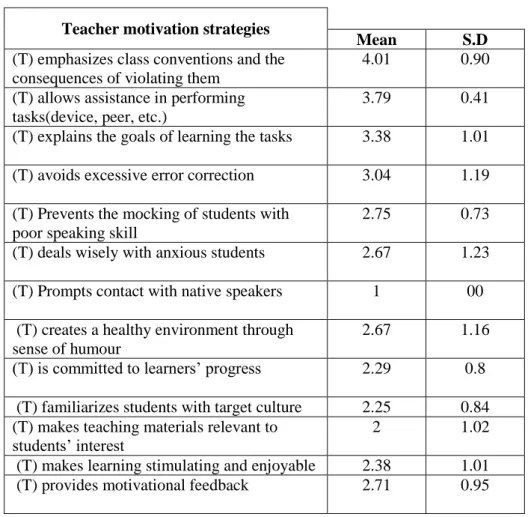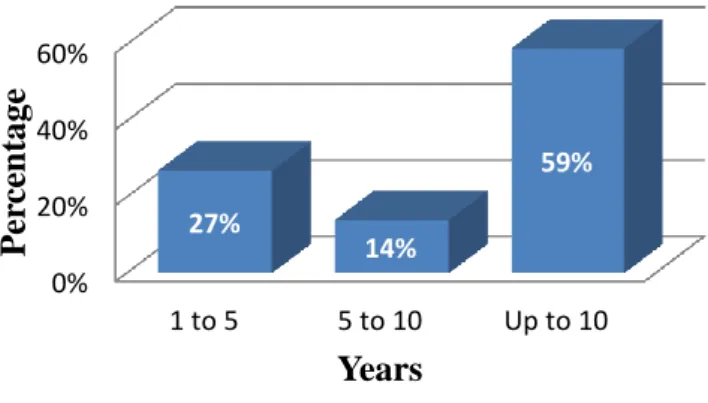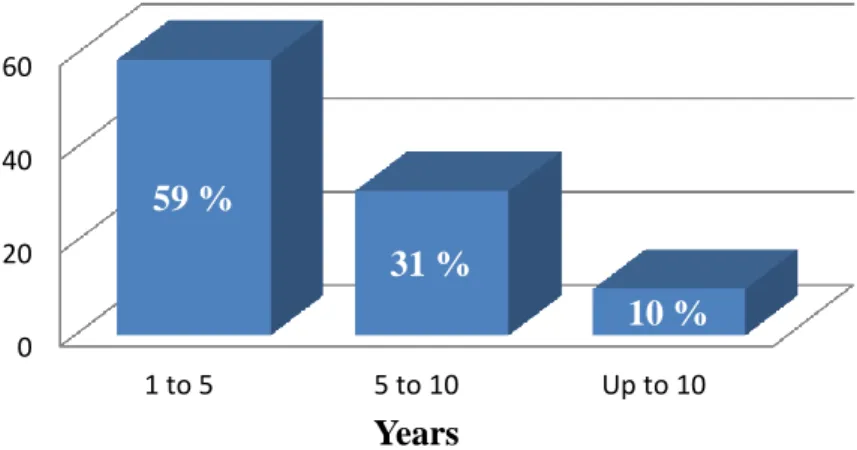People’s Democratic Republic of Algeria Ministry of Higher Education and Scientific Research
DJillali Liabes University of Sidi Bel Abbes Faculty of Letters, Languages, and Arts
Department of English
Thesis Submitted to the Department of English in candidacy for the “Doctorat” Degree in English Discourse Studies and Applied Linguistics
Supervised by: Prof. M.Y. BOULENOUAR Presented by: Abdelhak GUETTAF TEMAM
Board of Examiners
President: Dr. Fewzia BEDJAOUI Professor DLU of Sidi Bel Abbes Supervisor: Dr. M.Y. BOULENOUAR Professor DLU of Sidi Bel Abbes Examiner: Dr. Faiza SENOUCI Professor University of Tlemcen Examiner: Dr. Belkacem BENSEDDIK MC-A DLU of Sidi Bel Abbes Examiner: Dr. Abdellah BARAKA MC-A University of Mascara
Academic Year: 2020/2021
Teachers’ Motivation as a Pre-requisite to Classroom
Efficiency: Choosing Oral Expression Tasks for EFL
II Declaration
I, the undersigned GUETTAF TEMAM Abdelhak hereby declare that I am
the sole author of this thesis. To the best of my knowledge this thesis contains
no material previously published by any other person except where due
acknowledgement has been made. This thesis contains no material which has
been accepted as part of the requirements of any other academic degree in
English or in any other language.
This is a true copy of the thesis, including final revisions.
Date: ………
Name (printed letters): ………
III Dedications
I dedicate this work to my father Mohammed, who taught me that the best kind of knowledge to
have is that which is learned for its own sake. It is also dedicated to my mother, who taught me
that even the largest task can be accomplished if it is done one step at a time To my brothers Brahim, Salah Eddine, Abdel Nour, Abdelkarim, Abdelouahab, Djamel,
Mourad, Ali and Achraf who never hesitate to help me. To my sister Sabrina
To my friends Hassan, Hossin, Ramzi, Raouf, Badri, Achraf, Adel, Issam, Khayrou, Ayoub
Mohieeddine, Brahim, and Lahcen. To my colleagues
IV
Acknowledgements
First of all, I would like to thank Allah for helping me to finish this thesis.
I would like also to express my sincere gratefulness to Prof. Boulenouar for his insightful
criticisms, and patient encouragement to write this thesis in innumerable ways. Thanks
for your support and endless advice.
I express my deep appreciation to the board of examiners: Prof. Bedjaoui Fewzia
, Dr. Benseddik Belkacem, Dr. Snouci Fayza, and Dr. Baraka Abdellah for their efforts and
recommendations to make this work successful.
Special heartfelt thanks to the person who enlighten my way Dr. Meddour Mostefa who
gave me hope to carry on my thesis in times of depression and weakness.
I would like also to show my respect and gratitude to Dr. Saliha Chelli, Dr. Ouarda
Khaouni, and to all Colleagues at the department of English at Biskra University.
To all people who helped me in my career for their unconditioned encouragement and support.
V Abstract
The issue of learning motivation has been found to be linked to teachers’ practice in EFL classrooms. In order to enhance motivation and communicative skills in oral expression course, teachers may raise their awareness of motivational strategies to fit their practice in order to reinforce consistency and efficiency. Thus, methods of learning centeredness like task based language teaching involve considerations and principles for motivation, anxiety, settings, and feedback. The current study aims at finding a link between teacher motivation and their task practice in the course of oral expression. It is hypothesized that when teachers use the motivational strategies and principles of TBLT, their practice and task choice would be effective. The sample of the study composes of 29 teachers of oral expression of English at the University of Mohammed Kheider -Biskra-. In addition, a mixed method approach is used through concurrent triangulation design to deal with the phenomenon. Hence, three research tools are used: classroom observation, focus group interview with students, and a questionnaire. The research findings reveal that teachers have lack of awareness of principles of contemporary methods like TBLT and the motivational strategies. Moreover, we found that teachers’ motivation does not begin and ends in the classroom but it goes beyond its boundaries. To elaborate, teachers’ choice and practice of tasks are found to be affected by factors like the physical environment, lack of teaching materials, salary, uncooperative teaching, and administrative problems. Furthermore, one of the crucial consequences of the absence of teachers’ inspection and a unified course program is the use of personal courses taken from the Caneva description without insightful research. At the end of this research and to compensate these deficiencies, certain recommendations are discussed in order to recreate new policies to cope with the rapid change in educational systems. To conclude, results found in the current study may be helpful for teachers training and theory development.
VI
Key words: Caneva, Motivational Strategies, Oral Expression Course, Task Based Language Teaching, Task Practice, Triangulation
VII
List of Abbreviations and Acronyms
CEIL: Centre d’Enseignement Intensif des Langues EFL: English as a Foreign Language
EM: Extrinsic Motivation
ESL: English as a Second Language IM: Integrative Motivation
IQ: Intelligence quotient
ITE: Institut Technologique d’Education
LMD: Licence, Master, Doctorat O.E: Oral Expression
S.D: Standard Deviation
SPSS: Statistical Package for Social Sciences T: Teacher
TBLL: Task Based Language Learning
TBLT: Task Based Language Teaching TD: Travaux Dirigés
VIII List of Figures
Figure1. 1: Maslow's hierarchy of needs, represented as a pyramid with the more basic
needs at the bottom ... 15
Figure1. 2: Gardner’s Socio-educational Model (Chiesa, Scott, & Hinton, 2012, P.58) .... 19
Figure1. 3: The components of motivational teaching Practice. (Alqahtani, 2015, p.51) ... 28
Figure 2. 1: Task Components. Retrieved from Nunan (2004, p. 41) ... 53
Figure 2. 2: Types of Tasks Based Planning. Retrieved from Ellis (2005, p. 4) ... 69
Figure 2. 3: Components of TBL Framework. Willis (1996, p. 38) ... 71
Figure 2. 4:Schematic Representation of the three mechanisms making up the motivational task processing system. Bygate and Samuda (Eds) p.119 ... 75
Figure 4. 1: Teachers' Degree Percentage ... 119
Figure 4. 2: Experience in Teaching English ... 120
Figure 4. 3: Experience in Teaching Oral Expression ... 121
Figure 4. 4 : Teachers' Sources of Motivation ... 122
Figure 4. 5: The Profession of Teaching ... 128
Figure 4. 6: Teaching Oral Expression Course ... 129
Figure 4. 7: Cooperation among Teachers ... 131
Figure 4. 8: Teachers' Motivation ... 133
Figure 4. 9: Unmotivated Teachers Affection ... 134
Figure 4. 10: Factors Affecting Teachers ... 135
Figure 4. 11: Factors of Tasks’ Practice in Oral Expression ... 138
Figure 4. 12: General Goals of O.E Caneva ... 139
Figure 4. 13: Modals/Methods in Planning Tasks ... 140
Figure 4. 14: Task Implementation ... 145
Figure 5. 1: Flexible classrooms. Retrieved from Google Pictures. ... 162
IX List of Tables
Table 2. 1: Assessment types of Validity. Retrieved from Nunan (2004, p.139)... 77
Table 4. 1: Classroom and Learning Environment ... 102
Table 4. 2: Schedule of Oral Expression ... 105
Table 4. 3: Pedagogical Environment... 106
Table 4. 4: Teachers’ motivational strategies ... 108
Table 4. 5: Teachers in Task Content Selection and Procedures... 113
Table 4. 6: Teachers’ Degree ... 119
Table 4. 7: Experience in Teaching English ... 120
Table 4. 8: Experience in Teaching English at University ... 121
Table 4. 9: Experience in Teaching Oral Expression ... 121
Table 4. 10: Teachers’ Sources of Motivation ... 122
Table 4. 11: Theories Related to Motivation ... 125
Table 4. 12: Profession of Teaching ... 128
Table 4. 13: Teaching oral Expression Course ... 129
Table 4. 14: Cooperation among Teachers ... 131
Table 4. 15: Teachers’ Motivation ... 132
Table 4. 16: Unmotivated Teachers Affection ... 133
Table 4. 17: Factors Affecting Teachers ... 135
Table 4. 18: Factors of Tasks’ Practice in Oral Expression ... 137
Table 4. 19: General Goals of O.E Caneva ... 138
Table 4. 20: Modals/Methods in Planning Tasks ... 140
Table 4. 21: Pre-task Strategies of Oral Expression ... 141
Table 4. 22: During-task Strategies of Oral Expression ... 142
Table 4. 23: Post-task Strategies of Oral Expression ... 142
Table 4. 24: Tasks Implementation ... 144
X Content Declaration... II Dedications ... III Acknowledgements ... IV Abstract ... V List of Abbreviations and Acronyms ... VII List of Figures ... VIII List of Tables ... IX
General Introduction ... 1
1. Statement of the Problem ... 1
2. Research Questions ... 5
3. Hypothesis ... 5
4. Research Methodology ... 5
5. Thesis Structure ... 6
CHAPTER ONE : GENERAL OVERVIEW ON MOTIVATION ... 8
Introduction ... 10
1. Historical Overview ... 10
2. Defining and re-defining Motivation ... 11
3. Theories of Motivation ... 12 3.1. Behaviourism Theory ... 12 3.2. Cognitive Theory ... 13 3.3. Drive Theory ... 14 3.4. Humanistic Theory ... 15 3.5. Metatheoretical Models ... 16 3.5.1. Mechanistic Model ... 16 3.5.2. Organismic Model ... 17 3.5.3. Contextual Model ... 18 4. Types of Motivation ... 18 4.1. Integrative Motivation ... 18 4.2. Instrumental Motivation ... 20 4.3. Intrinsic Motivation ... 20 4.4. Extrinsic Motivation ... 22
5. Factors of Demotivation for Teachers ... 23
XI
5.2. Salary/ Students’ Achievement ... 24
5.3. Working Environment ... 25
6. Motivational Strategies ... 27
6.1. Dörnyei’s Motivational Strategies Framework (2001b) ... 27
6.1.1. Creating Basic Motivational Conditions ... 28
6.1.1.1. Appropriate Teacher Behaviour ... 29
6.1.1. 2. A pleasant and Supportive Atmosphere in The Classroom ... 29
6.1.1. 3. A Cohesive Learner Group with Appropriate Group Norms... 30
6.1.2. Generating Initial Motivation ... 31
6.1.2.1. Familiarising Learners with L2 Culture and L2-Related Values ... 31
6.1.2.2. Increasing the Learners’ Expectancy of Success ... 32
6.1.2.3. Increasing the Learners’ Goal-Orientedness ... 32
6.1.2.4. Making the Teaching Materials Relevant for the Learners’ Needs and Goals ... 33
6.1.3. Maintaining and Protecting Motivation ... 33
6.1.3.1. Making Learning Stimulating and Enjoyable ... 34
6.1.3.2. Protecting the learners self-esteem and self confidence ... 34
6.1.3.3. Promoting Learners Autonomy... 35
6.1.3.4. Providing Motivational Feedback ... 36
6.1.3.5. Increasing Learner Satisfaction ... 37
Conclusion ... 38
CHAPTER TWO : FOREIGN LANGUAGE TASKS ... 39
Introduction ... 41
2.1. Definitions of Speaking Skill ... 41
2. 2. Distinction between Speech and Writing ... 44
2.3. Definition of Tasks in Foreign Language Learning ... 45
2.4. Foreign Language Task Principles ... 48
2.4.1. Scaffolding ... 49 2.4.2. Task Dependency ... 49 2.4.3. Recycling ... 50 2.4.4. Active Learning ... 50 2.4.5. Integration ... 50 2.4.6. Reproduction to Creation ... 51 2.4.7. Reflection ... 51
XII
2.5. Foreign Language Task Component... 52
2.5.1. Goals ... 53
2.5.2. Input ... 54
2.5.3. Procedures ... 54
2.5.4. Teachers and Learners Roles ... 55
2.5.5. Setting ... 57
2.6. Foreign Language Tasks Features ... 57
2.6.1. A Task is a Workplan ... 57
2.6.2. A Task Involves a Primary Focus on Meaning ... 58
2.6.3. A Task Involves a Real-World Processes of Language Use... 58
2.6.4. A Task Can Involve Any of the Four Language Skills ... 58
2.6.5. A Task Engages Cognitive Processes ... 59
2.6.6. A Task has a Clearly Defined Communicative Outcome ... 59
2.7. Types of Tasks ... 61
2.8. Focused and Unfocused Tasks ... 66
2.9. Sequencing Tasks ... 68
2.9.1. Ellis (2005) Framework ... 69
2.9.2. Willis (1996) Framework ... 70
2.10. Foreign Language Task Motivation ... 73
2.11. Assessment of Tasks ... 76
Conclusion ... 79
CHAPTER THREE : RESEARCH METHODOLOGY ... 81
Introduction ... 82
4.1. Research Approach and Method ... 82
4.2. Sample of The study ... 83
4.3. Research Tools ... 84
4.3.1. Classroom Observation ... 86
4.3.1.1. Aims of Observation ... 86
4.3.1.2. Participants ... 87
4.3.1.3. Description of the Observation ... 87
4.3.1.4. Observation Analysis Procedures... 88
4.3.1.5. Sections of the Classroom Observation ... 91
XIII
4.3.2.1. Aim of the Interview ... 92
4.3.2.2. Participants ... 92
4.3.2.3. Description of the Focus Group Interview ... 93
4.3.2.4. The Interview Piloting ... 93
4.3.2.5. Procedures of Focus Group ... 94
4.3.3. Teachers’ Questionnaire ... 94
4.3.3.1. The Pilot Questionnaire ... 95
4.3.3.2. The Aim of the Questionnaire ... 96
4.3.3.3. Description of the Questionnaire... 97
4.3.3.4. Procedures of Questionnaire Analysis ... 98
Conclusion ... 99
CHAPTER FOUR : ANALYSIS OF THE RESULTS ... 100
Introduction ... 101
4.1. Analysis of Classroom Observation ... 101
4.1.1. The physical environment ... 101
4.1.2. The Pedagogical Environment ... 105
4.1.3. Teacher Motivation Strategies ... 108
4.1.4. Tasks and Content in Speaking ... 112
4.2. Analysis of the Focus group Interview ... 115
4.2.1. Physical Environment ... 115
4.2.2. Focus on Grades and Superficial Feedback ... 116
4.2.3. Teacher’s Talk Time ... 117
4.2.4. Students’ Interests ... 117
4.2.5. Lack of Group Work ... 117
4.2.6. Access to Teachers ... 118
4.3. Analysis of the Questionnaire... 118
4.3.1. Section One: General Information ... 119
4.3.2. Section Two: Teachers Perception of Motivation ... 122
4.3.3. Section Three: Motivation in Teaching ... 128
4.3.4. Section Four: Oral Expression Module ... 137
Conclusion ... 146
CHAPTER FIVE : DISCUSSION OF THE RESULTS, RECOMMENDATIONS, AND CONCLUSION ... 148
XIV
5.1. Discussion of the Results ... 150
5.1.1. The physical Environment ... 151
5.1.2. Teaching Problems Spotted in the Study ... 154
5.1.2.1. Teachers awareness VS Teachers’ Practice ... 154
5.1.2.2. Cooperation among Teachers ... 155
5.1.2.3. Sources of Motivation to Teachers... 157
5.1.2.4. Constructive Feedback ... 158
5.1.2.5. Students’ Interests and Task Selection ... 159
5.1.2.6. Workload and Supervision ... 159
5.1.2.7. Biological Needs ... 160
5.2. Recommendations for Future Prospects ... 161
5.2.1. Flipped Classrooms ... 162
5.2.2. Evaluation of Tasks ... 164
5.2.3. Use of ICTS ... 167
5.2.4. Salary ... 168
5.2.5. Decreasing the Number of Student at the Department of English ... 170
5.2.6. Allocation for More Teachers Appointment ... 170
5.2.7. Adding More Sessions for Oral-Expression Course ... 171
5.2.8. Encouraging team-work and Courses Training ... 172
5.2.9. Implementing Inspection (Supervision) at the Algerian University ... 174
5.2.10. Availability of a Psychologist (s) at the Department ... 176
5.3. Limitations of Study ... 177 Conclusion ... 178 General Conclusion ... 179 Glossary ... 181 References ... 182 List of Appendices ... 204
Appendix 1: Consent Letter ... 205
Appendix 2: Focus group interview participants ... 206
Appendix 3: Classroom observation ... 207
Appendix 4: The focus group interview (before piloting) ... 209
Appendix 5: The focus group interview (after piloting)... 211
XV
Appendix 7: Teachers’ questionnaire (the piloting version) ... 236
Appendix 8: Teachers’ questionnaire (the final version) ... 244
Résumé ... 251
1 General Introduction
Motivation has always been in the heart of educational research as it remains an area of multifaceted and extensive investigation. It is considered as primary incentive in EFL classrooms and its existence has given importance on both developmental and educational practices. It is often identified as an omnipresent factor of high impact on learners’ desires, interests, attitudes, and antecedents to trigger and reshape their choices and achievement rates. Hence, teachers quality, characteristics, style play an exceptionally influential role in guiding learners tendencies and forming their learning goals and attitudes on their achievement levels more than instruction and content (Morrel &Lederman,1998). Therefore, the rationale behind the present research is then to explore the correlation between teachers’ motivation, factors of motivation, and tasks practice in EFL classrooms at the University of Biskra.
1. Statement of the Problem
It is commonly known that a good teacher can change students' life positively around them. Teacher-student relationships are of supreme importance for the success of both teachers and students. As for classroom management, this kind of relationships is the most substantial factor in determining the success or failure of teachers’ work. Teachers have to demonstrate a unique compassion, perseverance, diligence, sincerity, research orientation, honesty and flexibility as a person. Teachers also need to be solicitous in the way they react to students’ comments. Generally, teachers react by using praise, acceptance, remediation, or criticism in responding to students. Derk as stated in (Mehdipour & Balaramulu, 2013)
Many factors contribute to students’ learning like family, financial status, the learning environment. Studies suggest that the paramount factor is the teacher because it is a direct key to the success or failure of second/foreign language learning. In any learning
2
situation, good quality of teaching required good teachers to facilitate tasks for students to attain satisfactory education outcomes.
The dominant view is that effective teachers have a full range of skills and techniques to meet the changing needs of classroom demands and learners’ needs. In this study, we believed that teacher is an important component as it influences and guides the learning process and can be reflected in particular strategies. Teachers’ certificates or experiences may not affect the process and only deep investigation into qualities related to teachers’ performance during the process and their reflections on learners’ progress can reveal many other features. In fact, this is the real problem at the Algerian university where there is no teachers’ evaluation, observation or appraisal.
To be able to explore the relationship between teaching motivation and teachers’ practice in oral expression; we relied on task based language teaching approach and the strategies of motivation as a guide to check whether teachers adopt its main basis on teaching that course. First, in a Task Based Language teaching (TBLT) the teacher builds activities on the completion of a central task and the language determined by what happens during task completion rather than determining the aspect of language to be studied. It is advantageous in many ways for being active, communicative where students spend much time communicating where they are not expected to have language control. Further, a natural context is developed from the students' experiences with the language that is personalized and relevant to them in which students can have a more varied exposure to the language. Therefore, for successful language task teaching, the study attempted to make a link between motivation and teachers’ performance, task planning, task selection, and factors that may hinder or prevent the process from running smoothly.
3
In Algeria, teachers’ supervision and evaluation is a neglected aspect in the higher education system. Though to attain a high degree of professionalism in any institution, we require strong evaluation systems to provide detailed, timely and actionable feedback with reference to clear professional practice. Evaluation provides feedback about strengths and weakness of teachers as well as lesson plans and students’ needs in terms of resources, materials and management. Unfortunately, in the Algerian higher education system, evaluation is done from a general scope for different purposes such as getting promotion, certificate, or academic leaves. Besides, the measures used to evaluate the teachers are irrelevant with classroom practice or learners’ outcomes. Teacher quality in Algerian universities is believed to cover professional and administrative requirement more than caring and focusing on students’ needs and learning outcomes. Many teachers get promoted because they respected superficial laws such as punctuality, responding to administration requests, attending exams and participating in department activities even if their practice in the classroom is unsuccessful. Thus, teachers’ qualities in real teaching such as personal attributes with students, classroom management and organization, implementing instruction and monitoring students’ success are totally absent.
It was perceived then found in the results of the study that teachers of O.E in Biskra are not following contemporary methods in teaching the course. Most of them think that they are adopting learner-centred instructions, yet they are using random choices of their own such as book reviews and dialogues without deep processing or planning of tasks chosen because they might be proposed by another teacher or because the teacher considers them as a perfect choice without putting students’ interests into account. Students along the year have never been given an opportunity to reflect upon the learning tasks or express their feeling towards the content given. Each teacher relies on the Caneva
4
description to plan and select certain courses according to his/her own perspective of the course which may lead to inaccurate and inconsistent results among different classes of the same level. Regardless the lack of equipment in classrooms, some teachers are striving to bring different materials to help students learn better; however, the majority are not giving importance to implement any of these materials.
In this research, we are trying to come at logical and objective results through exploring teachers’ motivation from two angles. First, teachers’ practice and performance during the process were emphasized such as strategies of motivation implemented and considerations of dealing with tasks in the process to explore deeply motivation. In addition, to process thoroughly the situation, prerequisites of effective teaching such as physical environment, factors affecting teachers were investigated. The second angle is students’ perceptions. In order to adequately examine teachers’ practice and the area of their influence, it is required to put students’ views into consideration. Research studies integrating students’ attitudes of teachers’ qualities are of great importance (Mainhard, 2015). Teaching practice also includes peculiar interpersonal relationships in which both teachers and students influence each other in different ways; therefore, a wider approach to this problem is needed. It is important to note that scarce studies explore teachers’ characteristics based on mere standpoint of students (Misbah et al., 2015). This kind of approach might bring forward the problem and enrich theoretical approaches regarding teachers’ quality and their impact on students' attitudes towards learning. Hence, the results of this research could be relevant for teaching practice and contribute to raising the quality of education.
5 2. Research Questions
Based on what we stated in the problematic, we have come to raise the following questions:
Do teachers have the required prerequisites of effective teaching? Do teachers have enough knowledge about motivational strategies? Does motivation affect teacher’s task design?
Do teachers teach oral expression using task-based instruction?
3. Hypothesis
It is assumed in this study that when teachers are motivated, they tend to teach oral expression tasks effectively. Therefore, we hypothesize that:
- When teachers use motivational strategies, their teaching quality would be enhanced - When teachers adopt the principles of TBLT, their task-practice would be effective - When teachers use TBLT, they plan and choose learning tasks effectively.
4. Research Methodology
A mixed-methods approach involves the collection and analysis of qualitative and quantitative driven data in a single study. Methodologically, this practice is evidenced by the fact that acting in such a way can open up and offer the researcher insightful feedback that may help to achieve the set out research goals.
In the present study, such a nature of this investigation requires adopting a mixed-methods approach in order to understand the perceptions of, and reactions towards, the innovative act through a qualitative interpretative perspective.. We believe that no single research approach can provide us with the suitable explanations of what we are researching. Rather, we assume that combining the two approaches is more appropriate.
6
The researcher decided to opt for three data collection methods. This number of tools seeks to gain rich information, and in the meantime corroborate the findings by cross checking the results. The selected data collection methods are a questionnaire, an observation, and an interview.
The sample of his study is divided into two categories major and minor (check chapter 3). The reason behind using two samples is cross checking recorded results in order to obtain valid and verifiable data. Second, the notion of motivation inside the classroom requires the interpersonal relationships between teachers and students and that bond cannot be disassociated. Thus, 29 teachers participated in answering the questionnaire among which 6 were observed, and finally 9 students were interviewed.
5. Thesis Structure
In addition to the general introduction and general conclusion, the thesis is divided into 5 main chapters. Chapter one provides a background information about and literature review on the motivation starting from definitions, history, factor of demotivation, theories, types of motivations, and strategies.
Chapter two indicated the background information and literature review of Tasks starting from definitions, principles, components, features, sequencing tasks, and assessment of tasks.
Chapter three describes research methodology adopted in the current study. The chapter describes and overview of the methods selected and the reason behind using them, sample of the study, research tools, and data processing tools.
Chapter four represents research data analysis, checking teachers’ knowledge of motivational strategies, factors affecting teachers, and their implementation of TBLT
7
principles through the in-depth analysis of questionnaire, observation, and focus group interview by making analysis via Atlas software, Excel and SPSS.
Chapter five is concerned with the interpretation of data obtained, pedagogical implication for further research, and limitations of the study. It provides meticulous discussion about the phenomenon compared to other studies in the literature review.
8
CHAPTER ONE
GENERAL OVERVIEW ON MOTIVATION
Introduction ... 10 1. Historical Overview ... 10 2. Defining and re-defining Motivation ... 11 3. Theories of Motivation ... 12 3.1. Behaviourism Theory ... 12 3.2. Cognitive Theory ... 13 3.3. Drive Theory ... 14 3.4. Humanistic Theory ... 15 3.5. Metatheoretical Models ... 16 3.5.1. Mechanistic Model ... 16 3.5.2. Organismic Model ... 17 3.5.3. Contextual Model ... 18 4. Types of Motivation ... 18 4.1. Integrative Motivation ... 18 4.2. Instrumental Motivation ... 20 4.3. Intrinsic Motivation ... 20 4.4. Extrinsic Motivation ... 22 5. Factors of Demotivation for Teachers: ... 23 5.1. Lack of Interest in The Teaching Profession ... 23 5.2. Salary/ Students’ Achievement ... 24 5.3. Working Environment ... 25 6. Motivational Strategies ... 27 6.1. Dörnyei’s Motivational Strategies Framework (2001b): ... 27 6.1.1. Creating Basic Motivational Conditions ... 28 6.1.1.1. Appropriate Teacher Behaviour ... 29
9
6.1.1. 2. A pleasant and Supportive Atmosphere in The Classroom ... 29 6.1.1. 3. A Cohesive Learner Group with Appropriate Group Norms... 30 6.1.2. Generating Initial Motivation ... 31 6.1.2.1. Familiarising Learners with L2 Culture and L2-Related Values ... 31 6.1.2.2. Increasing the Learners’ Expectancy of Success ... 32 6.1.2.3. Increasing the Learners’ Goal-Orientedness ... 32 6.1.2.4. Making the Teaching Materials Relevant for the Learners’ Needs and Goals ... 33 6.1.3. Maintaining and Protecting Motivation ... 33 6.1.3.1. Making Learning Stimulating and Enjoyable ... 34 6.1.3.2. Protecting the learners self-esteem and self confidence ... 34 6.1.3.3. Promoting Learners Autonomy... 35 6.1.3.4. Providing Motivational Feedback ... 36 6.1.3.5. Increasing Learner Satisfaction ... 37 Conclusion ... 38
10 Introduction
Motivation is important in education because it influences mental and physical reactions of both teachers and learners. Highly motivated teachers have the potential to practice this art efficiently and effectively by increasing productivity, learning achievement, and high grades which are the required features of a qualified teacher. Low motivation can be caused by a lack of direction or purpose, lack of teachers’ motivation, classroom environment as it can be intrinsic or extrinsic. This chapter spotlights recent perspectives concerning motivation to understand its value, its historical investigations development, and tackling some models and theories. Moreover, the chapter aims at finding out the factors behind teachers’ motivation and the strategies they adopt.
1. Historical Overview
Pakdel (2013) claimed that the word motivation can be traced from ancient Greek philosophers like Aristotle, Plato, and Socrates. Plato believed in the regular hierarchy based on nutrition component, emotional component and rational component. However, Aristotle used distinct reforms which were different from the Plato belief .He, and for more than twenty years, focused on spirit with the belief that nutrition and emotional components are part of the body and they are in one way or another responsible for motivation. Thus, they are the stimulation for growth, physical comfort (food) and some experiences such as pain and pleasure (emotional). These two parts form together the irrational motivation power. Therefore, the logic section was including all types of rational features of the spirit such as voluntary aspects and intellectual concepts (ibid).
11
In the modern era after the Renaissance, René Descartes (as stated in Pakdel, 2013) distinguished between active and inactive features of motivation:
The body is inactive factor of motivation, while will is active factor of motivation. Body has a physical and mechanical nature with nutrition desires that answer to those desires by senses and physiological reflects to external environment (p.240).
For René Descartes, the body is useless without an internal incentive to do an action. Hence, the physical and the physiological conditions feed everyone’s desire to realize a concrete objective.
2. Defining and re-defining Motivation
Motivation is a term derived from the Latin word “movere” which means to “move”. It is used in different disciplines in life which denotes for an inner feeling of enthusiasm that guides behaviour. Abisamra (2006) stated that it is the state of adrenaline flowing in the blood that is linked mostly with a strong desire to reach an objective.
Another theorist, Dornyei (1990), postulates a motivational construct model consisting of an integrative motivation, an instrumental motivation, need for achievement, and attribution for past failures. He suggested that instrumental motivation might be more important than integrative motivation for foreign language learners. He also suggested that instrumental and integrative motivation in EFL environments should be considered as two motivational subsystems that overlap in some areas: the need for achievement and students' personal goals. He found that these types of motivation are present in the learners’ mental thinking and they use their past failures every time to reshape their strategies to attain success in the acquisition of a second language.
Speaking about motivation is dated back to behavioural approaches like classical conditioning and operant conditioning. The former has not been given much importance
12
because it was based on the mere principle of stimulus and response with total neglect to the functions of the brain which were considered at that time as a Black Box. However, the former was given scope because of its positive impact on learners’ outcomes. Accordingly, we can try to motivate pupils to work hard in school by using rewards such as praise and merit points, or sanctions such as detentions. In the same sense, scholars like Bernaus and Gardner (2009) claimed that some learners are motivated just because of inner energy with less affection to outer factors because of self-esteem and self-orientation. Therefore, two terms here are mentioned: intrinsic and extrinsic motivation. Intrinsic as stated is the inner stamina (energy) to make an act; however, extrinsic is the effect of external factors on learners’ desires and behaviours.
3. Theories of Motivation
In the endeavour to understand human behaviour, motivation examines the inherited and acquired needs as well as the process related to these needs of human behaviour.This interest to understand motivation and its causes and effects on people; gave birth to a number of motivational theories. These theories attempt to explain why people think, perceive, and behave in certain ways whether individually or in groups (Deci & Ryan, 1985).
3.1. Behaviourism Theory
Behaviourism arose out of the ideas of early 20th century learning theorists who attempted to explain all learning in terms of some form of conditioning. (Demirezen, 1988) explained that the Behaviourist theory, which is basically a psychological theory in its essence, founded by J.B. Watson, is actually a theory of native language learning, advanced in part as a reaction to traditional grammar. The supporters of this theory are Leonard Bloomfield, O.N. Mowrer, B.F. Skinner, and A.W. Staats. Behaviourism was advanced in America as a new approach to psychology in the early decades of the
20th-13
century by making a particular emphasis on the importance of verbal behaviour, and received a considerable trust from the educational world of 1950s The core issue of behaviourist approaches is the way in which simple stimulus and response connections were built up. Early behaviourist perspectives explain motivation in terms of reinforcement (Alqahtani, 2015). In addition to this, Skinner (1953) assumed that an individual is conditioned to take actions by being rewarded or punished. He ignored internal forces and believed that motivation is a reflection of external forces.
The notion of conditioning has been extended by Skinner in the operant conditioning. His theory is based on providing more incentives to reinforce voluntarily behaviours. Therefore, this theory has implications in education in which teachers should manipulate the environment in order to engage students in tasks, encourage them to make an effort so that they can interact and respond to stimuli.
3.2. Cognitive Theory
In contrast to behaviourism theory, cognitive theory assumed that motivation cannot be observed directly through behaviours but rather observing its internal process through behaviours (Pintrich & Schunk, 2002). The dominant aspects of cognitive theory involve the interaction between mental components and the information that is processed through this complex network that is involved: attributions, perceptions, goals, values, and effect (Clint, 1993). In education, students are expected to work hard because of their experiences and lead them to the belief that hard work will be rewarded in the future. In addition to that, teachers have to consider what proper contexts that might stimulate mental processes of students in the classroom and how to manipulate the instructional and social factors that affect students’ behaviours and thoughts (Alqahtani, 2015).
14 3.3. Drive Theory
A theory of motivation developed by Clark L. Hull, the Drive-Reduction Theory focuses on how motivation originates from biological needs or drives. In this theory, Hull proposed a person’s behaviour is an external display of his desire to satisfy his physical deficiencies (Sincero, 2012). Clark L. Hull was working at Yale University (U.S.A) when he began to develop the drive-reduction theory. He was inspired by several scientists as John Watson, Ivan Pavlov, Edward Thorndike, and Charles Darwin. His theory was based on the principle of physiological equilibrium believing that behaviour is stable when these needs are satisfied. In addition to that, Hull explained that an individual is in a state of urge when his survival is threatened. When a person’s drive emerges, he will be in an unpleasant state of tension and the person will behave in such a way that this tension is reduced. To reduce the tension, he/she will begin seeking out ways to satisfy his biological needs. For instance, you will look for water to drink if you are thirsty. You will seek for food if you are hungry (Hull, 1943).
This theory has no real application nowadays in education. It has been criticized because it does not provide explanation about the reasons behind individuals engaging in behaviours that are not meant to reduce certain drives like someone eating even if he/she is not hungry. Second, reinforcements as drink and food reduce people drives because they are primary reinforcements; however, this theory is not applicable to secondary reinforcements like money for example, we can use money to purchase food but money in itself cannot reduce the individuals’ drives.
15 3.4. Humanistic Theory
The humanistic approach in psychology developed as a rebellion against the behaviourist theory because some psychologists saw it as a limited and poor theory. (McLeod, 2015) stated that Humanism rejected the assumptions of the behaviourist perspective which is characterized by reinforcement of stimulus-response behaviour and heavily dependent on animal research. Humanistic psychology also rejected the psychodynamic approach (relationships between behaviours, feelings and past experiences) because it is deterministic, with unconscious irrational and instinctive forces determining human thought and behaviour (ibid).
Rogers a well-known humanistic theorist, believed that “it is a function of the whole organism as central source of energy in the human organism; rather than some portion of it; it is best conceptualised as a tendency toward fulfilment, actualisation, toward the maintenance and enhancement” (Alqahtani, 2015, p. 15).
Abraham Maslow (1970) another humanistic psychologist believed that people are motivated by survival and other needs. Hence, he identified five components: physiological, security, needs of belonging, esteem, and self-actualization.
Figure1. 1: Maslow's hierarchy of needs, represented as a pyramid with the more basic needs at the bottom
16
It is obvious that motivation as Maslow stated above is attained through progressive stages. The first is the need to eat, drink and bodily comforts (physiological). The second component is the feeling of security and to avoid danger and disorientations in life. Among safety, affiliating with others, being accepted and loved are true senses of belonging which is in fact the responsibility of a family, tribe, and/or country and it is considered as an incentive to motivation. Consequently, if our objectives are not highly desired, motivation will be reduced and sometimes vanished. When the previous components are stick together, they produce self-esteem and self-satisfaction which are identified as the internal peace that promotes learners’ painstaking, self-actualization, and creativity.
3.5. Metatheoretical Models
According to Damon and Lerner (2006), metatheories, in scientific discussion, are theories in the sense that they determine the context in which theoretical concepts are constructed. The primary function of metatheory is to provide a rich source of concepts out of which theories and methods grow. In addition to that, it provides guidelines to avoid conceptual confusions. Metatherotical models include metaphors in order to understand concepts, assumptions, and principles of theories (Pintrich & Schunk, 2002). In this part, three metatheoritcal models (mechanistic, organismic, and contextual) are presented to explain how these models deals with assumptions of different theoretical approaches of motivation.
3.5.1. Mechanistic Model
Theories built on the mechanistic model focus on the role of the eternal environment in directing and constructing developmental change. Assembling a computer from its component parts, like circuit board and other parts resemble biological and physical factors that provide foundation for human development. However, psychological
17
functioning is built-up through active intervention from developmentally nurturant environment. This model concentrates on analysing complex, mature behaviour at earlier beginnings and into simpler segments (Peterson, 2014).
Norwich (2000) has found that the basic metaphor in this model is the machine where the same fundamental categories and assumptions operate. These include the idea that operates as chain-like sequences. This is applied in psychology when individuals are regarded as reducible to simple elements, which have regulated by prior causes.
3.5.2. Organismic Model
In contract with the mechanistic model, the organismic model of development views the organism (and the environment) as inherently active and constantly changing. (Reese, 1976) argued that this model follows from the assumption or metaphor of an “active organism” that the organism’ behaviour cannot be predicted completely under those models. On prior grounds, organismic models assume that the behaviour of organism and the behaviour of environment are interdependent and, therefore, their interaction cannot be meaningfully analysed into sequences of cause and effect
Haaften, Korthals and Wren (1997) stated that the organismic model pays special attention to the subject of development. The activity of the organism is goal-Directed. A certain form of subjectivity may be attributed to the organism by removing obstacles and thus determines its conditions to a certain degree. The development of moral thought is not just seen as the outcome of genetic predisposition and environmental factors, but rather is regarded as the result of active adaptation to the environment in accordance with the goals and needs of the organism. This model can be used in the study of development of individuals, groups, and societies. The former is seen as a process in which human beings
18
are actively involved in regulating their thought and actions according to their interests and needs.
3.5.3. Contextual Model
Shaffer (2009) claimed that the contextual model views development as the product of a dynamic interplay between the individual and the environment. People are assumed to be active in the developmental process (as in the organismic model) and the environment is active as well (as in the mechanistic model). Development may have both universal aspects and aspects peculiar to certain cultures, times, or individuals. The potential exists for both continuous and discontinuous change, and development may proceed along many different paths, depending on the intricate interplay between internal forces (nature) and external influences (environment).
Simply, this model considers children as active entities whose developmental paths represent a continuous and dynamic interaction between inner power (nature) and external impact (nurture).
4. Types of Motivation
According to research and the perspectives of scholars, motivation energizes and guides behaviour towards a specific outcome. In the following part, distinctive types of motivation are identified; as well as stating the characteristics of each type.
4.1. Integrative Motivation
Integrative motivation is an important element in Gardner’s theory of motivation. It is an important component in the socio-educational model of second language acquisition. Gardner (1985, p.54) defined the term as the following:
“The concept of integrative motive includes not only the orientation but also the motivation (i.e. attitudes towards learning the language plus desire plus motivational intensity) and a number of other attitude variables involving the
19
other language community, out-groups in general and the language learning context.”
Gardner (as stated in Nakata, 2006) suggested that integrative motivation is a composite construct of made up of three main components: integrative orientation, interest in foreign language including attitudes towards the L2 community and attitude towards learning situation. Based on this definition, in the socio-educational model, integrative motivation plays an important role in language learning.
Figure1. 2: Gardner’s Socio-educational Model (Chiesa, Scott, & Hinton, 2012, P.58) In this model, the variable integrativeness reflects a genuine interest in learning the second language in order to come closer to the other language community (Dornyei & Schmidt, 2001). The second variable is attitudes towards the leaning situation, which involves attitudes towards any aspect of the situation in which the language is learned.
20
These attitudes could be directed toward the teacher or any materials or activities related to the course in general. The last variable motivation refers to the driving force at any situation i.e. motivation, in this model, to learn second language, is viewed as:
a) Motivated individuals expend effort to learn language by seeking more opportunities to learn more.
b) Motivated individuals want to succeed and strive to achieve a goal.
c) Motivated individuals will enjoy the tasks of learning the second language (ibid).
4.2. Instrumental Motivation
Gardner ( as stated in Sergan, 2015) claimed that instrumental orientation is “ a goal that doesn’t seem to involve any identification or feeling of closeness with the other language group, but instead focus on a more practical purpose learning the language would serve for the individual”(p.5). Gardner also as stated in (Samad, Etemadzadeh, & Far, 2012) suggested that instrumental motivation refers to “more functional reasons for leaning a language to get a better job or a promotion, or to pass a required examination” (p.433).
Instrumentally motivated learners need to learn the language and learn about the country where the language is spoken, whereas integrally motivated learners learn the language for their own sake, for their pleasure, to satisfy their needs without the necessity of rewards (Nakanishi as stated in Guler, 2018)
4.3. Intrinsic Motivation
Deci and Ryan (2000) defined the term intrinsic motivation as doing an activity for its inherent satisfaction rather than doing it for any reward or any other consequences. In addition to that, Shadish & Fuller (1994) suggested that individuals who are intrinsically motivated engage in a task because the task in itself is interesting, enjoyable or personally challenging to the individual. Moreover, Deci (1975) claimed that people seem to engage
21
in the activities for their own sake and not because they lead to an extrinsic reward. The activities are ends in themselves rather than means to an end.
Noel, Pelletier, Clément, and Vallerand (1990) proposed three-part taxonomy of intrinsic motivation. The first type of IM is IM-Knowledge, which is the motivation for doing an activity for the feelings associated with exploring new ideas and developing knowledge. The second type, IM-Accomplishment, refers to the sensations related to attempting to master a task or achieve a goal. The third type, IM-Stimulation, relates to motivation based simply on the sensations stimulated by performing the task, such as aesthetic appreciation or fun and excitement. The common basis of these three subtypes is the pleasurable sensations experienced during the self-initiated and challenging activity.
Further, Guay, Vallerand, and Blanchard (2000, pp.177-178) postulated four important components for self-determination theory: Competence, Autonomy, relatedness, and the need for self-esteem to understand the initiation and regulation of behaviour.
a) Competence: implies the need for having an effect, for being effective in one’s interactions with the environment.
b) Autonomy: a sense of feeling free from pressures and to have the possibility to make choices among several courses of action.
c) Relatedness: refers to interpersonal attachments and bonds developed between individuals and are based on a fundamental striving for contact with others.
d) Self-esteem: learners who feel good about themselves are more likely to have a positive attitude to the subjects and related activities.
22 4.4. Extrinsic Motivation
Deci and Ryan (2000) defined extrinsic motivation as engaging in an activity as a means to an end and for its own sake. Thus, extrinsically motivated individuals do not participate in an activity for the inherent pleasure they may experience but rather, to receive something positive or to avoid something negative. Rutledge (2008) stated that behaviours, changes, and influences controlled by external factors are extrinsic motivators that might be flexible and unpredictable within each individual’s definition of worth or meaning. Baumeister and Vohs (2007) claimed that extrinsic motivation is the desire to do something because of the rewards and reinforcement it brings. However, one would probably do not do the behaviour if one did not get something.
Noels, Clément, and Pelletier (2001) learning, extrinsic motivation (EM) includes three sub-types. The first is external regulation, where a student learns an L2 because of some pressure or reward that comes from the social environment, such as career advancement or a course credit. Once that pressure or reward is removed, the learner might be expected to stop putting effort into L2 learning. Introjected regulation refers to more internalized reasons for learning an L2, such or shame. As with external regulation, once the pressure is lifted, engagement in the activity is likely to fall off. Identified regulation is the most self-determined type of EM that has been examined in the L2 context. In this case, the student learns an L2 because she has personally decided to do so and because that activity has value for her chosen goals. As long as that goal is important, the learner can be expected to persist in L2 learning.
23 5. Factors of Demotivation for Teachers
Most of studies focused mainly on learner motivation and demotivation rather than on teacher motivation and demotivation in the EFL context. Hence, aspects like lack of interest in the profession, salary, students’ achievement, and working environment will be discussed.
5.1. Lack of Interest in the Teaching Profession
It is widely argued that the status of teachers in most countries, both developed and developing, has declined substantially during recent decades. However in Tesfaye and Demewoz (2004) explained in their study that inclination towards the teaching profession took a rain check over the last forty years mostly due to the status attached to the profession. According to them, teaching is profession that people join when they are not capable of finding an alternative job which pays more. In this regard Motuma (2006) also confirmed that most teachers enter in to the profession because it is easier to get than other jobs or to make money (their earning) out of it till they get another job among other reasons. Commitment refers to the attachment and loyalty. As defined by (porter et al., 1974) cited in Armstrong (1995) commitment is a relative strength of the individual’s identification with, and involvement in, a particular organization. Moreover, he draws the conclusion that: high organizational commitment is associated with higher motivation and good performance. One of the causes of organizational commitment is job satisfaction. People who are satisfied with their job are more committed to their organization than those who are less satisfied. Sylvester (2010) demonstrated a high positive relation between professional commitment and job satisfaction. He held that the factors like location of institute, educational qualification and years of teaching experience of teacher educators have impact on their attitude towards teaching profession as well as level of job satisfaction. Attitude measurement has very wide currency, the new curriculum emphasizes
24
,particularly in social psychology, that a curriculum should be based on the students' learning interests, life experience and cognitive levels, and that it can promote more educational processes of participation, communication and, enable specific learning targets to be followed (ibid).
Job performance has generally been conceptualised as a function of ability and motivation. It is thought to be responsible for why people decide to do something, how long they are willing to sustain the activity and how hard they are going to pursue it. Mesheck (2016). It is the reason for action, and the term used to define the success or failure of any complex task like teaching (Brown, 1990).
5.2. Salary/ Students’ Achievement
Some studies suggest that features of teacher quality like teacher education, teaching experience, and teacher certification, have a positive impact on academic achievement of learners (Hu, 2009). Salary is an important stimulus and reward scheme in education. Hence, teacher characteristics as the link between teacher salary and teacher quality indicates that rational teacher salary policy will significantly impact educational performance of learners’ outcomes.
Another study on student intelligence tests and educational spending found that Asian American students’ IQ was positively related with teacher salary per hour (Hama 2007). The same study also showed that the average teacher salary of countries that have better performance in Program for International Student Assessment (PISA) was 1.5 times higher than those that did worse. Another example in Zimbabwe in which teachers’ salaries in 2010 were as low as 220 US for a senior teacher. Most pupils were performing below grade level and some schools scored 0% pass rate in public examinations (Mesheck, 2016).
25
Morphet (2009) claimed that there is a positive relationship between one’s own motivation and his/her performance. Thus, every worker who has a passion and desire to work on something will result in a high performance as well. Likewise, the income have a tremendous connection to one's motivation and adequate incomes will trigger sufficient motivation.
5.3. Working Environment
Studies about teacher performance, student academic achievement, and building condition propose that the physical environment quality significantly influence teacher satisfaction and student achievement. Earthman (2004) stated that there is plethora of research to state without equivocation that the teaching and learning environment especially the classroom in which teachers and students spend a good deal of their time does in fact affect how well they interact and perform.
Siegel (as stated in Massey, 2004) found that there was a direct relationship between architectural design of the classroom and teachers’ behaviours and actions inside the classroom. Space arrangement has instant and far reaching consequences for teacher's capability to effectively and efficiently achieve daily activities, the formation of social and professional relationships, and the sharing of knowledge. Besides, Consideration of the spaces where teachers meet and collaborate is just as important as the design of the classroom (ibid).
There is a volume of research that suggests that less successful and less attentive leaners are specifically affected by the table’s arrangement. However, their on-task behaviour increasing very positively when seating configurations changes from one task to another. (Higgins et al, 2005) advocates of open plan educational institutions; argue that teachers should allow learners to learn the way suited them because each individual has
26
same style of learning. The most effective teaching and learning strategies without considering physical design may hinder teachers to work productively. The traditional classroom seating arrangement with tables lined up in rows impede teachers' efforts to work in groups and have students in the flexible and varied groupings necessary (Higgins et al, 2005).
In order to facilitate teachers’ work, certain decent facilities make additional contributions to help teachers well performing. Hence, plenty of research examines the effect of the classroom conditions of teaching spaces (which involves seating, furnishing, spatial density, noise and acoustics, climate and thermal control, air quality, windowless classrooms, vandalism and play-yards, light and colour) on teachers and students’ motivation, interaction, attendance, and wellbeing (ibid).
Some important contentions about the physical aspects of learning spaces include:
a) Temperature: heating and air quality are the most important individual elements for any process to run healthy.
b) Chronic noise exposure impairs cognitive functioning: many studies finding noise-related reading problems, deficiencies in pre-reading skills, and more general cognitive deficits.
c) Colour remains the topic of some of the most optimistic claims about morale and efficiency: the choice of the best use of colours is dependent on the age of learners (brighter for younger students, more subdued for adolescents), as well as differences between males and females (males – bright colours, females – softer). d) Using visual displays in classrooms breeds success because students are provided
27 6. Motivational Strategies
Many previous studies gave importance on creating motivational frameworks theoretically and focused on establishing the effectiveness of motivation on the EFL/ESL learning/teaching contexts, rather than trying to show how to motivate learners in the classroom. Dörnyei (2001a) argued that the most stressful issue related to motivation is not what motivation to provide but rather how it can be increased. Too much consideration and effort has been devoted to find and analysing several motives and validating motivational theories than to developing strategies and techniques to increase motivation for classroom practices (ibid).
Until the 1990’s, investigation about strategies of motivation did not receive much attention and there has been a scarce empirical studies on them. Dörnyei (2001b, p.28) defined motivational strategies as “the motivational influences that are consciously exerted to achieve some systematic and enduring positive effect”. Guilloteaux and Dörnyei (2008) described motivational strategies as instructional interventions applied by the teacher to elicit and stimulate student motivation, self-regulating strategies that are used purposefully by individual students to manage the level of their own motivation. Alrabai (2010, p. 59) conceptualized motivation strategies as “the techniques that are used for the purpose of enhancing individuals’ goal-related behaviour”.
6.1. Dörnyei’s Motivational Strategies Framework (2001b)
In his book of motivational strategies in the language classroom, Dörnyei (2001b) has developed a systematic framework of L2 motivational strategies known by Motivational Teaching Practice which composes of various strategies that can be implemented to positively influence leaners behaviours and endure the comfort zone. Also, they initiate, generate, and maintain learners’ motivation in the classroom. This model comprises of the following four areas: Creating Basic Motivational Conditions; Generating
28
Initial Motivation; Maintaining and Protecting Motivation; and, Encouraging Positive Self-evaluation, each of which are discussed below.
Motivational
Teaching Practice
Figure1. 3: The components of motivational teaching Practice. (Alqahtani, 2015, p.51)
6.1.1. Creating Basic Motivational Conditions
In order to generate motivation inside he classroom, certain conditions should be included. These conditions include appropriate teacher behaviour, a pleasant and supportive atmosphere, and a cohesive learner group with appropriate group norms.
Creating the basic motivational conditions Appropriate teacher behaviours
A pleasant and supportive classroom atmosphere
A cohesive learner group with appropriate group norms
Generating initial motivation
Enhancing the learners’ L2- related values and attitudes
Increasing the learners’ expectancy of success
Increasing the learners’ goal-orientedness
Making the teaching materials relevant for the learners’ needs and goals
Maintaining and protecting motivation
Making learning stimulating
Protecting the learners’ esteem and increasing their self-confidence
Promoting learner autonomy
Providing motivational feedback
Increasing learner satisfaction
29 6.1.1.1. Appropriate Teacher Behaviour
Dörnyei and Csizér’s (1998) study suggested that teachers’ behaviours are an influential tool in the language classroom. Also, appropriate teacher behaviour can be observed in the classroom through numerous aspects, such as their enthusiasm for teaching, commitment to students’ learning, and their good relationship with the students. They suggest that if the content and style of explanation is enthusiastic, important, and unique, leaners are likely to show the same interest and motivation as that of the teacher.
As Dörnyei (2001b) indicated, appropriate teacher behaviour may include also displaying commitment to leaners progress by adopting learners learning seriously. To elaborate, learners’ progress may involve monitoring learners’ development closely and frequently, especially with low-achieving learners, will provide the sufficient help to keep them on the track of the process. According to him, this strategy cannot be exaggerated because the role of the teachers is to make sure that learners know that their success is of a great importance to him and to prepare them to work hard to achieve that purpose. However, the fastest way to decrease learners’ motivation is to make them feel that their teacher is careless about their progress (ibid)
6.1.1. 2. A pleasant and Supportive Atmosphere in The Classroom
Dörnyei (2001a) considered that teachers should be aware that the anxiety generated by the classroom milieu can be one of the most influential factors undermining the effectiveness of learning and motivation. A Good teacher is encouraging and patient person so that to provide as much learning opportunities as possible to occur within a healthy and supportive atmosphere. According to him, one of the most effective ways for creating a pleasant classroom atmosphere is through using humour (Dörnyei, 2001b). He remarked that integrating sense of humour in the classroom is not only to tell jokes but
30
rather to show a relaxed attitude and avoid taking everything happens in the classroom seriously. When learners feel the teacher is permissive and provides a degree of self-mockery; therefore, learners interact more and become engaged in the learning process.
6.1.1. 3. A Cohesive Learner Group with Appropriate Group Norms
Group cohesiveness is one of the features of group dynamic that influences language learners’ motivation. Dörnyei (1994, p. 279) defined group cohesiveness as “the strength of the relationship linking the members to one another and to the group itself”. In a later (2001a) publication, Dörnyei described group cohesiveness in terms of the strength of inter-member relations, or the magnetism or glue that holds the group together and maintains it as a system.
Dörnyei (2001a) investigated the link between motivation, self-confidence, and group cohesiveness. He found that perceived group cohesiveness significantly contributed to the learners’ overall motivation. Thus, learners’ motivation tends to increase in cohesive class groups, which is due to the fact that learners in such groups share an increased responsibility for achieving the group goals and the positive relation between them makes learning more enjoyable.
The second feature of group dynamic is group norms. Dörnyei (2001b) defined group norms as “the rules or standards that describe behaviour that is essential for the efficient functioning of the group”. Learning norms refer to the norms found in educational contexts by the group leader (the teacher). Besides, they should emphasise these norms to make learners fully aware to respect them. If the group members feel that these norms are not given much attention by the teacher, they are consequently tend to ignore these norms. It is very important to explain in details these norms to the group
